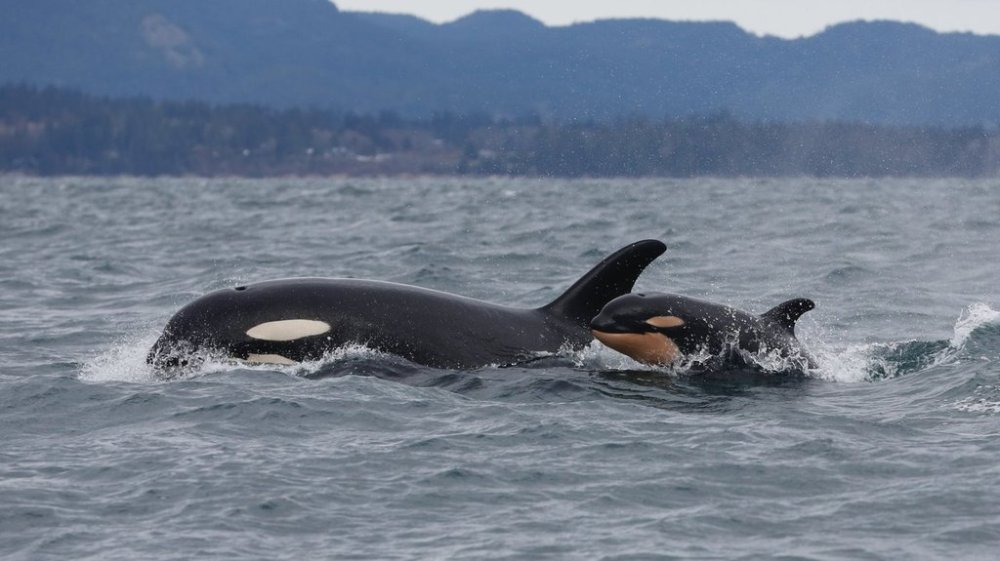Science
Southern Resident Killer Whales Face Decline Without Urgent Action

A recent survey indicates that the endangered southern resident killer whales are on a gradual decline, raising concerns about their long-term survival. According to Michael Weiss, a director with the Center for Whale Research, this population is plateauing and moving toward potential extinction due to insufficient protective measures. The findings were released in an annual survey conducted as of July 1, revealing that the population now stands at 74 individuals, an increase of one from the previous year.
The survey highlights several critical factors contributing to this decline. Weiss pointed out that diminishing populations of chinook salmon, along with pollution and noise pollution from maritime traffic, particularly from cruise ships and tankers in the waters off Washington State and British Columbia, are impacting the whales’ habitat. He noted, “We’re not talking about southern residents going extinct in the next five years, but we are talking about a fairly good chance of at least one of the (three) pods being gone within the next 50 years.”
The report emphasizes the necessity of restoring chinook salmon habitats, especially freshwater spawning grounds, and making adjustments to fisheries to support the recovery of the orcas. The survey also recorded four births among the three distinct pods, yet only two calves survived. Additionally, the disappearance of an adult male from the K pod, known as K26, has raised alarms about the dwindling genetic diversity within the population.
According to Weiss, the population is facing significant inbreeding issues, resulting in low genetic diversity that could hinder their resilience against diseases. The survey identified 27 males of reproductive age, meaning older than ten years, but fewer are breeding. The youngest confirmed breeding male is only 15 years old, while Weiss considers males in their early twenties as being in their prime reproductive years. The loss of K26, the oldest male of its pod and one of the few confirmed successful breeders, represents a significant setback for the population.
The reproductive rate among females within the southern resident population is notably lower compared to their northern resident counterparts. Weiss stated that mortality rates among calves are alarmingly high—approximately 50 percent do not survive their first year. He explained that if these trends persist, the population will continue to decline.
K pod is in a particularly precarious position, with only 14 members, the lowest recorded in the survey’s 50-year history. Weiss remarked, “What’s really concerning about K pod is they’re just not reproducing.” The last successful birth in K pod occurred in 2022, and prior to that, it had been nearly a decade since a calf was born.
In contrast, J pod is experiencing some growth, attributed to a lower mortality rate for adults in recent years. Nevertheless, the population remains fragile, and Weiss cautioned that changes in mortality could quickly alter their current status. The survey also recorded merely 11 immature whales younger than ten years old, amounting to only 15 percent of the total population. This stands in stark contrast to the northern resident population, where immature orcas constitute 47 percent of their numbers.
While the southern resident killer whales share certain traits with the northern residents, their reliance on a specific salmon species, chinook, which has been declining, poses a unique challenge. The southern residents typically encounter the last of the chinook as they migrate from northern waters to the rivers along the Pacific coast. Weiss elaborated, “These salmon are going through, you know, fishing fleets and other killer whale populations and it’s the southern residents that are kind of getting the last bit of it.”
To aid in the recovery of these orcas, Weiss suggested restoring salmon habitats and relocating chinook fisheries away from ocean waters and estuaries. He emphasized that fishing practices in mixed waters make it increasingly difficult to protect declining fish populations. The urbanized habitats of the southern residents further complicate their survival, as they are forced to hunt in areas congested with cruise ships and freighters. “They’re trying to hunt in these areas where cruise ships and freighters are coming through every day,” he noted. “It’s trying to find food on a highway.”
As these findings highlight the urgent need for effective conservation measures, it is clear that coordinated efforts will be essential to prevent the extinction of the southern resident killer whales. This report by The Canadian Press was first published on October 13, 2025.
-

 Science3 months ago
Science3 months agoToyoake City Proposes Daily Two-Hour Smartphone Use Limit
-

 Health4 months ago
Health4 months agoB.C. Review Reveals Urgent Need for Rare-Disease Drug Reforms
-

 Top Stories4 months ago
Top Stories4 months agoPedestrian Fatally Injured in Esquimalt Collision on August 14
-

 Technology3 months ago
Technology3 months agoDark Adventure Game “Bye Sweet Carole” Set for October Release
-

 World3 months ago
World3 months agoJimmy Lai’s Defense Challenges Charges Under National Security Law
-

 Lifestyle4 months ago
Lifestyle4 months agoVictoria’s Pop-Up Shop Shines Light on B.C.’s Wolf Cull
-

 Technology3 months ago
Technology3 months agoKonami Revives Iconic Metal Gear Solid Delta Ahead of Release
-

 Technology3 months ago
Technology3 months agoApple Expands Self-Service Repair Program to Canada
-

 Technology3 months ago
Technology3 months agoSnapmaker U1 Color 3D Printer Redefines Speed and Sustainability
-

 Technology3 months ago
Technology3 months agoAION Folding Knife: Redefining EDC Design with Premium Materials
-

 Technology4 months ago
Technology4 months agoSolve Today’s Wordle Challenge: Hints and Answer for August 19
-

 Business4 months ago
Business4 months agoGordon Murray Automotive Unveils S1 LM and Le Mans GTR at Monterey









